
I learned about this trip at Train Festival 2009 and since Pere Marquette 2-8-4 1225 had been sidelined with a flue problem during the July event, it and Nickel Plate 2-8-4 765 would lead a double-headed steam excursion from Alma to Cadillac, Michigan in October. This was the first time since 1949 that the two engines had operated together and after not being able to ride behind Pere Marquette 1225, this was a no-brainer for me. Bob and Elizabeth decided to go and invited me to come along. Carole Walker of Buena Vista Travel booked me on Northwest Airlines to Detroit where I would meet my friends. I was still trying to find work so the days passed until it was time to pack for this trip.
To Detroit and Mt. Pleasant 10/2/2009Up early, I drove to the Santa Ana station parking lot and bought my Metrolink ticket to Los Angeles then walked over to Track 1 to wait for Metrolink 603. I went and bought my round-trip ticket on the Flyaway Shuttle to LAX. Thirty- two minutes later, I passed through security and waited at the gate doing Sudoku puzzles then boarded Northwest Airlines Flight 672 for Detroit. I listened to music as we travelled over a sea of clouds after reaching the Rockies. We landed early and soon I was in the McNamara Terminal where I had a Popeye's Chicken Dinner and about two-and-a-half hours to wait for my friends.
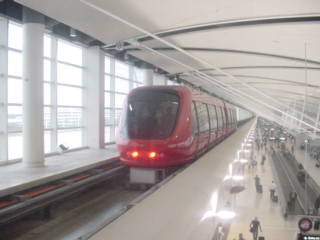
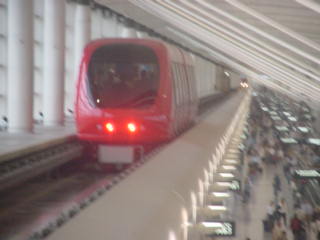
I rode a round trip on the Detroit Airport Tram before trying to access the Internet with no luck so listened to music and did more puzzles until it was time to take the shuttle bus to the North Terminal. Detroit, please put in a shuttle bus between the terminals so one does not have to pass through Security. I had to wait at the baggage claim area in a chair at the North Terminal then a little after 9:00 PM, Bob and Elizabeth arrived and after they picked up their luggage, we made our way to the rental car shuttle which took us Dollar Rental Car off the airport. There we received a KIA Optima and soon we were off to Mt. Pleasant, where we arrived after midnight and checked into the Baymont Inn for the night.
10/3/2009 After a McDonald's breakfast, we drove south to Alma and parked across the street from the boarding area for today's trip.
Our Engines for the Trip to CadillacPere Marquette 2-8-4 1225 built by Lima Locomotive Works in 1941. The largest and most impressive piece in the Steam Railroading Institute's collection, it is one of the largest operating steam locomotives in Michigan. The locomotive was used for ten years between Detroit, Toledo, Flint, Saginaw, Grand Rapids and Chicago; hauling fast freight for the products of Michigan factories and farms, including war material when Detroit was the "Arsenal of Democracy", producing huge volumes of vehicles, aircraft and armaments. The Pere Marquette Railway merged with the Chesapeake and Ohio in 1947, but the 1225 continued in service until its retirement in 1951 in favour of diesel locomotives.
In 1957, the locomotive was saved with the help of Forest Akers; Dodge Motors' Vice President and Michigan State University Trustee, who saw it as a real piece of machinery for Engineering students to study. Displayed as an icon of the steam era, it sat at MSU until 1969, when a group of students took an interest in the locomotive. The Michigan State University Railroad Club was formed at that time with the ambitious goal of restoring 1225 and using it to power excursion trains that would bring passengers to football games at the university. In 1982, under the newly-evolved Michigan State Trust for Railway Preservation Inc, the donated locomotive was moved to the former Ann Arbor Railroad steam backshop in Owosso where the restoration continued until 1985 when it moved under its own power for the first in 34 years.
Nickel Plate Railroad 2-8-4 765 built by Lima Locomotive Works in 1944. It was one of the Berkshire fleet known for its "superpower" technology and aesthetic charm. Once a fast-freight and passenger engine for the New York, Chicago & St. Louis Railroad - more commonly known as the Nickel Plate Road - the 765 is now a celebrated icon of American innovation and goodwill ambassador. Powered exclusively by volunteers as part of the Fort Wayne Railroad Historical Society's educational programs, the locomotive has been restored to the way it looked and sounded when it was originally built.
The plaque, mounted on the tender of 767/765, explaining the locomotive's preservation in 1963 as a "monument to a great period of development in our country -- the era of steam railroading." In the 1940's and 50's, the City of Fort Wayne, Indiana and the Nickel Plate Road sustained an interesting love-hate relationship. The iron roadbeds of the Nickel Plate, New York Central, Wabash and Pennsylvania railroads surrounded Fort Wayne. The Nickel Plate was nestled within the city; its West Wayne Yards were only blocks from downtown. The railroad's busy route on the northern end of the city kept Fort Wayne from expanding and persisted to displease motorists, who were constantly held up by the trains. Fort Wayne had already dealt with the problems inherent with ground level roadbed, as the Pennsylvania and Wabash to the south had elevated their tracks decades prior. To the north, a heated battle between the railroad and city ensued for years, with citizens chanting, "Elevate the Nickel Plate!"
With ground broken in 1947, the elevation of the Nickel Plate Road began in 1953 and ended in 1955 with a formal celebration that saw Nickel Plate Berkshire 767 parade across the elevated tracks, breaking a ribbon among station platforms crowded with spectators. A less informal event had been held some time before, when Nickel Plate Berkshire 765 became the first actual train to traverse the new rails. After earning the reputation as the "best of the west end" on the Fort Wayne Division, Berkshire 765 had been stored during its retirement in the enginehouse of the Nickel Plate Road in Fort Wayne. At the end of the steam era, several of the eminent Nickel Plate Berkshires locomotives were stored at the Nickel Plate's relatively new East Wayne yards, which had replaced the cramped quarters of the more urban West Wayne. Both 765 and 767 were among the sleeping sisters in the engine house and after sufficient slumber, 765 was fired up in 1958 to supply heat to a stranded passenger train in Fort Wayne. As other steam locomotives were scrapped, the engine would be saved at the request of the city that had once demanded the trains off the streets.
The City had asked for 767, but 765 proved to be in much better cosmetic and mechanical condition and, unlike other engines on the Nickel Plate, had been stored indoors for several years. During an inspection, 765 was deemed to be an ideal candidate for donation to the City of Fort Wayne. The roundhouse was asked to quietly change the locomotives' numbers and 765 -- renumbered as 767 -- was placed on display in Lawton Park within sight of the Nickel Plate elevation in May 1963. The real 767 was scrapped in Chicago in 1964. Fort Wayne's engine became a downtown showpiece, but after years of exposure to the elements, a group of local enthusiasts formed the Fort Wayne Railroad Historical Society to secure the locomotive for restoration. Seven days shy of the locomotive's 35th birthday on September 1st, 1979, 765 moved under its power for the first time in twenty-one years. The Fort Wayne Railroad Historical Society had become the first non-profit 501(c)(3) corporation in the world to restore and operate a mainline steam locomotive.
After a series of test runs on the Toledo, Peoria & Western in 1980, 765 would begin its rise to stardom as a fan trip favorite. Leased by the Southern Railroad for 22 trips in 1982, the locomotive earned its stripes on routes through mountainous terrain and rocketed across the midwest in later excursions out of Chicago, Fort Wayne, Cincinnati, and Buffalo, New York, to name a few. 765's reach extended as far east as New Jersey and south to Georgia, and found a calling on the head-end of the New River Trains through West Virginia, carrying behind it the longest passenger train excursions in history. Throughout the 1980's and early 90's, the FWRHS successfully partnered with CSX, New Jersey Transit and Norfolk Southern. 765 was also seen in the company of other locomotives such as Nickel Plate 587 and Norfolk & Western "Northern" 611 and their respective caretakers.
For 14 years, the locomotive proudly displayed the sights, sounds and smells of a bygone era of railroading, accumulating over 52,000 miles service entertaining and educating hundreds of thousands. In 1993, the 765 entered the shop for a complete overhaul that has since returned the engine to the condition it was in when it was first constructed. In 2005, a freshly rebuilt 765 left the restoration shop, on its way to make railroad history once again.
The Trip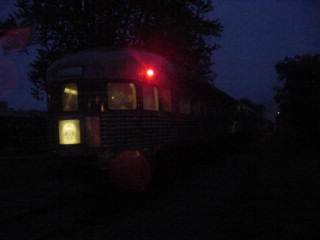
This was the rear of our train for today's trip to Cadillac. We walked forward to the engines.
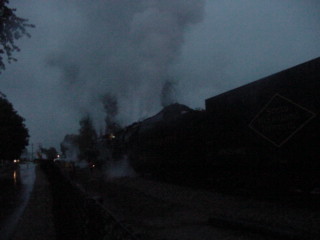
The two engines steaming away on a dark wet morning.


Nickel Plate 765 would be on the point of our train.
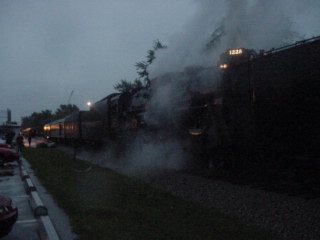
Pere Marquette 1225 would be the trailing engine.
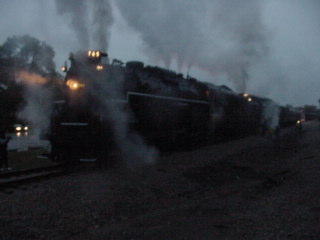
Nickel Plate 765 with headlight blazing this morning.
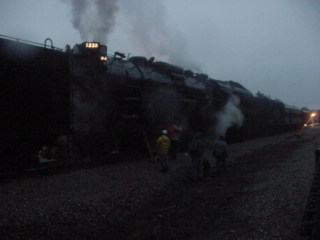
Pere Marquette 1225. I boarded the train in my open window car, Ohio Central 705. Our train's consist Nickel Plate Road 2-8-4 765, Pere Marquette 2-8-4 1225, MTSX auxiliary tender 5000, Pere Marquette 1225 crew car, Nickel Plate Road 765 crew car, Ohio Central open air cars 705 and 704, Canadian National coach 5226, Canadian National coach 5228, MARC lounge 147, VIA lounge 762, VIA coach 5646, VIA coach 5576, VIA coach 5581, Great Lakes Central coach, Southern coach 829, Grand Trunk Western dining car 899 "Silver Lake", Richmond, Fredericksburg and Potomac 857 and Seaboard Coast Line observation car 6004.
At 8:30 AM, the rest of the passengers boarded then the engines reversed onto the train and half an hour later, the train started forward.
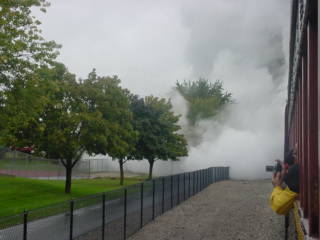
Leaving Alma.

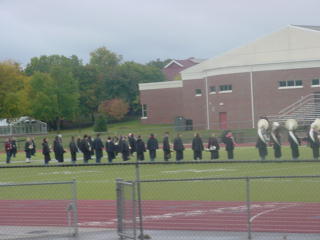
Our departure stopped the Alma College Band from practicing as they all turned to watch the train depart.
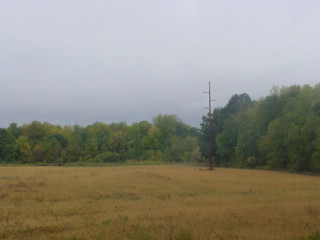
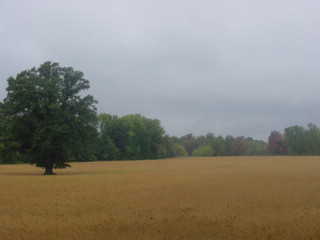
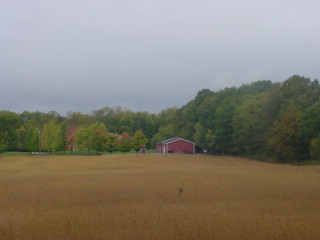
We made our way into the countryside and I started looking for trees in fall colours.

The engines smoking it up heading north.

Corn fields.
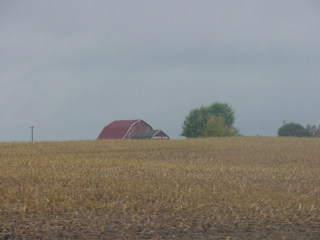
Red barns dot the Michigan countryside.
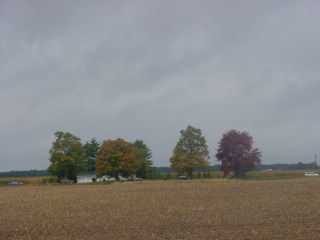
Trees in fall coluors.
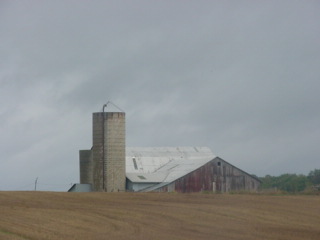
Another farm along our route.
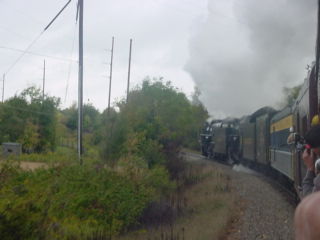
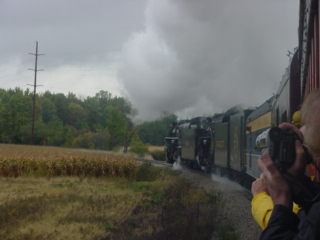
A curve on the way to Mt. Pleasant.
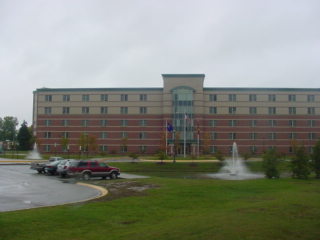
A dormitory at Central Michigan University in Mt. Pleasant.
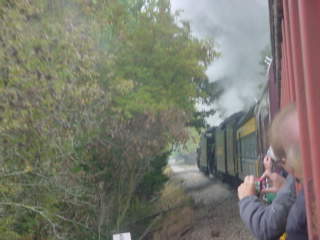
A curve north of there.

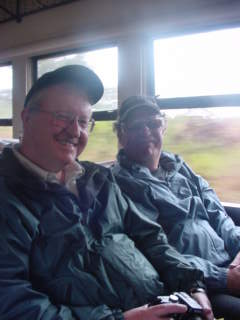
Myself wearing safety glasses and an acquaintance whom I met on this excursion, Richard Hall, who sat beside me in the open car.
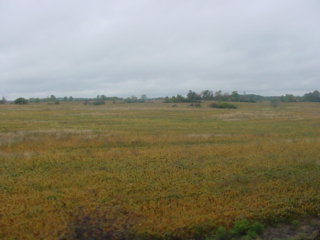
Colours out in this field.
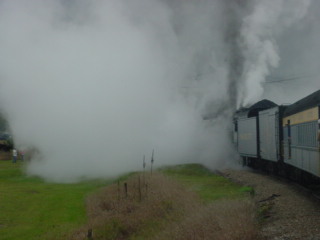
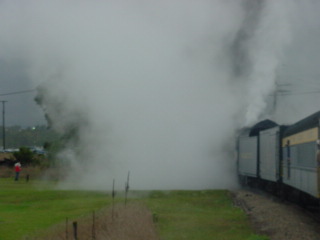
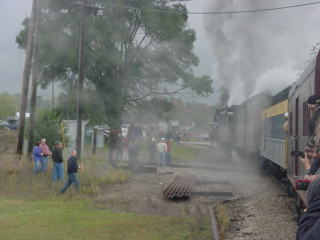
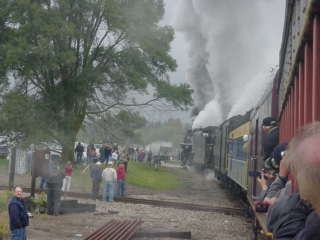
Now you see the engines and now you don't, during a blow down in Clare as we crossed the former Chesapeake and Ohio line from Coleman.
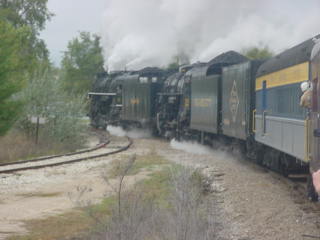
A good view of the engines as we left Clare.
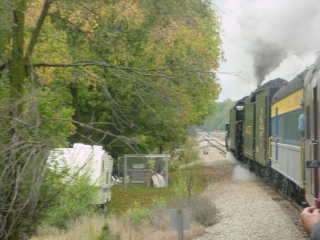
On our way to Cadillac.
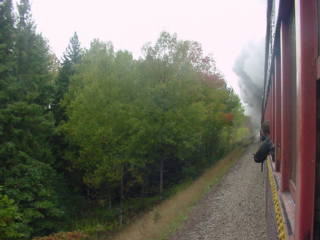
Colours in the trees along our route.

The train crossed this stream.

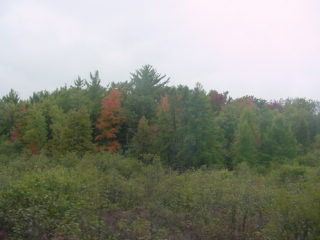
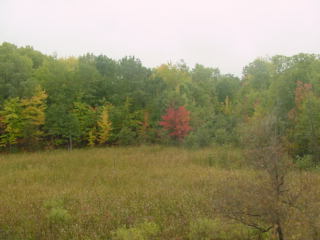
Evergreen and deciduous trees.
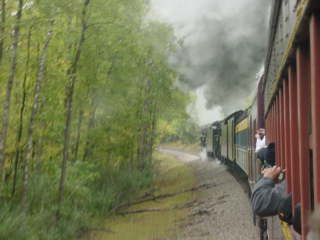
Taking another curve on the way north.
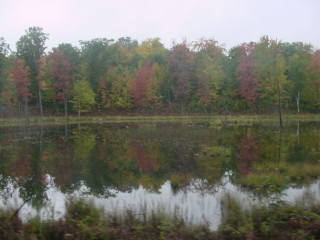
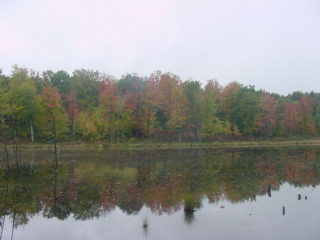
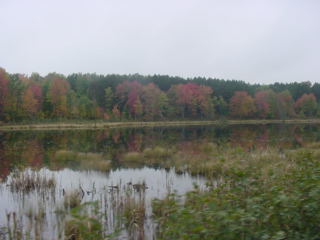
The trees reflecting in Little Loon Lake.
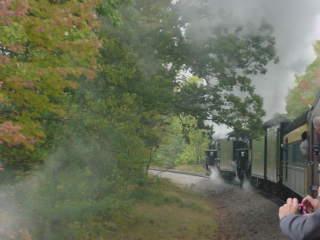

Rounding yet another curve.
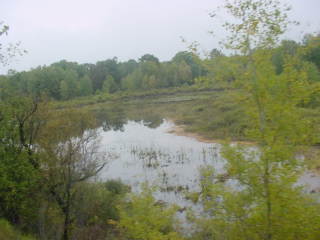
Passing an unamed lake.
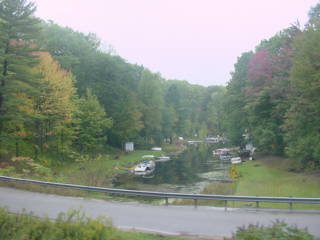
An arm of Lake George.
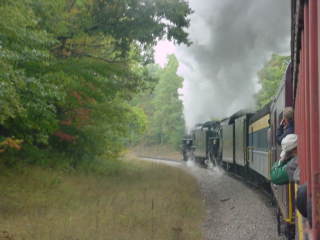
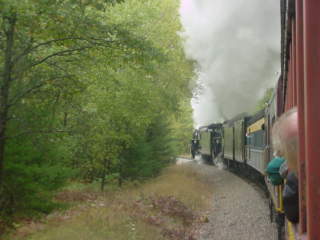
We rounded this curve to reach Lake George.
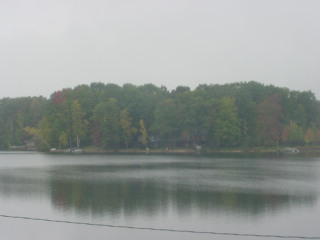
Lake George, a 60-acre natural lake in Clare County.
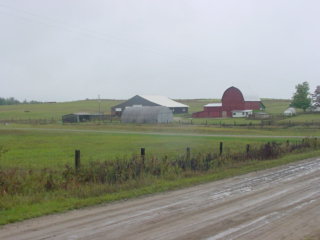
I love farms and red barns.
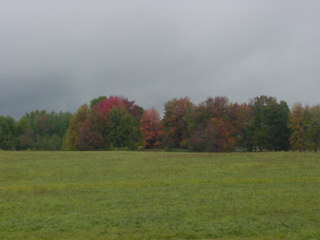
Beautiful trees on a dark morning.
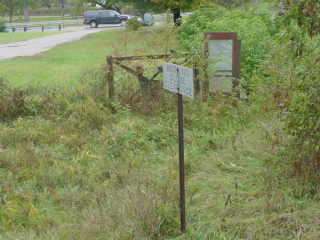
We stopped at Marion and this scene was outside my window, giving rise to two questions which will probably never be answered: Close clearance to what? and why a screen door? A few passengers boarded here before we resumed our journey north.
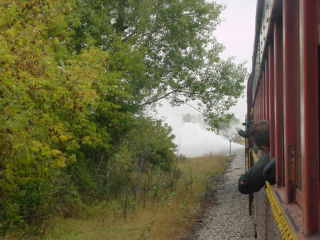
The engines blew down as we departed Marion.
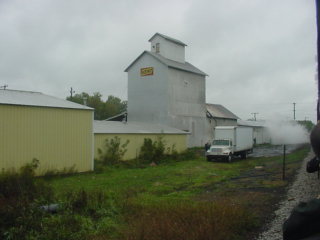
A Kent grain elevator in Marion.
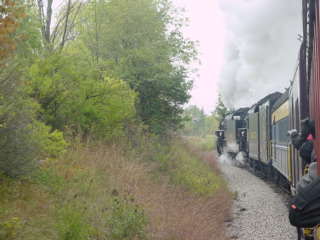
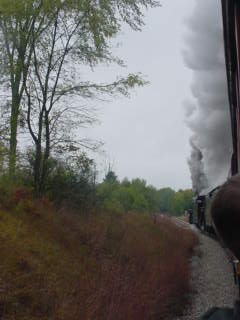
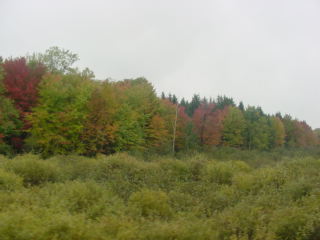
Our train took another curve.
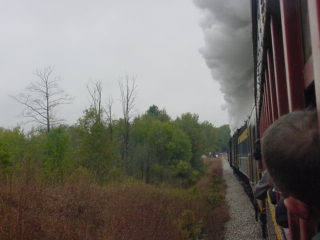
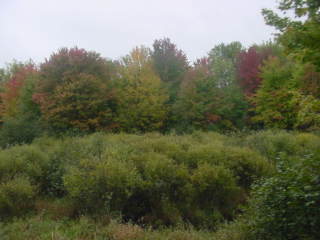
More trees as we continued towards Cadillac.
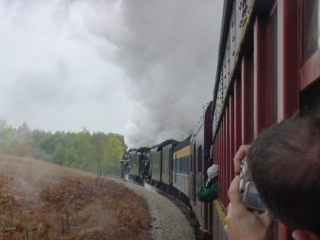
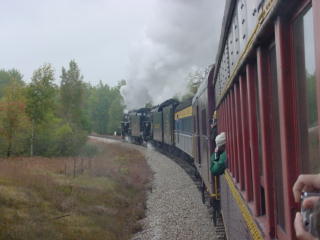
Two views on an open curve.

Passing a Christmas Tree farm.